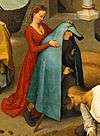The Blue Cloak
.jpg)
The Blue Cloak, or De Blauwe Huik, refers to an old title for a popular 1559 painting by Pieter Bruegel the Elder with a series of Netherlandish Proverbs. The painting, which is not inscribed, teases the viewer into guessing proverbs. It is based on a 1558 engraving by Frans Hogenberg that is accompanied by a written title and written proverbs. The title of that engraving is Die blau huicke is dit meest ghenaemt, maer des weerelts abvisen he beter betaempt (English: Often called 'The Blue Cloak', this could better be called 'The World's Follies'). The popularity of both the print and the painting can be seen from the number of copies that have survived, as well as later engravings and genre works inspired from individual scenes in the original print. Theodoor Galle also made a print, dated later, with a similar title: Dese wtbeeldinghe wort die blauw hvyck genaemt, maer deze werelts abvysen haer beter betaemt.[1]
In all three versions, the blue cloak or huik plays the central role:
 Breughel
Breughel Hogenberg
Hogenberg Galle
Galle
Later versions: The painter David Teniers the Younger, who married Brueghel's granddaughter, also made a painting with his own modern interpretation of the same proverbs in 1645, which also surround a central "Blue cloak" scene:
Adultery
The central figure is a woman who is pulling a blue cloak over her husband. She is literally pulling the wool over his eyes. This act is a metaphor for adultery, explicitly the adultery of the woman, and the cloak somehow helps her husband to "not see it", which is also indicated by another proverb or expression in the Galle engraving showing a man with his fingers in front of his eyes with the remark "Dese siet door de vingeren" (English: This one acts blind but is 'peeking through his fingers').
 Breughel
Breughel.jpg) Hogenberg
Hogenberg.jpg) Galle
Galle
Huik

The cloak is called a 'huyck' or huik in modern Dutch, and it was a black garment that was worn by women when they went outside the home in the 17th-century. It is unknown why the color of the huik plays a role in the proverb. That the huik was meant to be blue was emphasized not only by the common title, but also by the use of a black huik elsewhere in the painting. This secondary appearance of the huik can also be seen in the Hogenberg and Galle engravings, though it doesn't play a central role. The use of the huik in everyday Dutch life survived up to the 20th-century in various funeral rituals in remote areas such as Wieringen.[2] The garment is a large rectangular black wool sheet that is gathered together at the top and attached to a felted visor or cap. It was wide and long enough so that one hand could pull the edges together to cover the entire body. Over time the garment became shorter and shorter until it fell out of use altogether.

.jpeg) Skating in a village, 1610, by Hendrick Avercamp
Skating in a village, 1610, by Hendrick Avercamp Portrait of Emerantia Beresteyn, 1634 by Pieter Claesz Soutman
Portrait of Emerantia Beresteyn, 1634 by Pieter Claesz Soutman Mourning clothes, 1733, by Bernard Picart
Mourning clothes, 1733, by Bernard Picart
References
- ↑ C. C. Barfoot and Richard Todd, The Great Emporium: the Low Countries as a cultural crossroads in the Renaissance and the eighteenth century (1992), p. 128; Google Books.
- ↑ Film on YouTube showing use of the huik at a funeral in Wieringen, courtesy of the Zuiderzeemuseum
